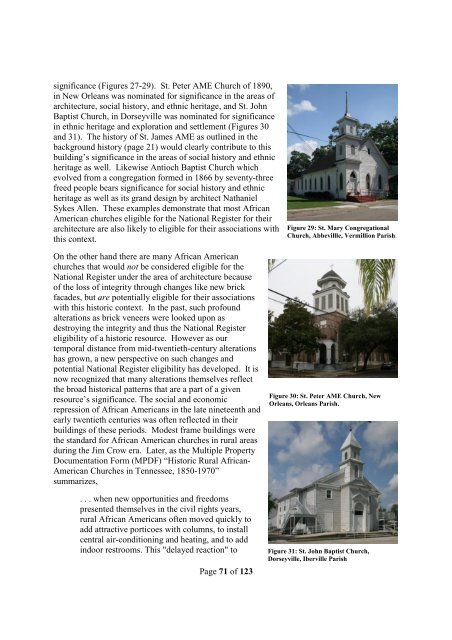The African American Experience in Louisiana
The_African_American_Experience_in_Louisiana
The_African_American_Experience_in_Louisiana
- No tags were found...
You also want an ePaper? Increase the reach of your titles
YUMPU automatically turns print PDFs into web optimized ePapers that Google loves.
significance (Figures 27-29). St. Peter AME Church of 1890,<br />
<strong>in</strong> New Orleans was nom<strong>in</strong>ated for significance <strong>in</strong> the areas of<br />
architecture, social history, and ethnic heritage, and St. John<br />
Baptist Church, <strong>in</strong> Dorseyville was nom<strong>in</strong>ated for significance<br />
<strong>in</strong> ethnic heritage and exploration and settlement (Figures 30<br />
and 31). <strong>The</strong> history of St. James AME as outl<strong>in</strong>ed <strong>in</strong> the<br />
background history (page 21) would clearly contribute to this<br />
build<strong>in</strong>g’s significance <strong>in</strong> the areas of social history and ethnic<br />
heritage as well. Likewise Antioch Baptist Church which<br />
evolved from a congregation formed <strong>in</strong> 1866 by seventy-three<br />
freed people bears significance for social history and ethnic<br />
heritage as well as its grand design by architect Nathaniel<br />
Sykes Allen. <strong>The</strong>se examples demonstrate that most <strong>African</strong><br />
<strong>American</strong> churches eligible for the National Register for their<br />
architecture are also likely to eligible for their associations with<br />
this context.<br />
Figure 29: St. Mary Congregational<br />
Church, Abbevillle, Vermillion Parish.<br />
On the other hand there are many <strong>African</strong> <strong>American</strong><br />
churches that would not be considered eligible for the<br />
National Register under the area of architecture because<br />
of the loss of <strong>in</strong>tegrity through changes like new brick<br />
facades, but are potentially eligible for their associations<br />
with this historic context. In the past, such profound<br />
alterations as brick veneers were looked upon as<br />
destroy<strong>in</strong>g the <strong>in</strong>tegrity and thus the National Register<br />
eligibility of a historic resource. However as our<br />
temporal distance from mid-twentieth-century alterations<br />
has grown, a new perspective on such changes and<br />
potential National Register eligibility has developed. It is<br />
now recognized that many alterations themselves reflect<br />
the broad historical patterns that are a part of a given<br />
resource’s significance. <strong>The</strong> social and economic<br />
repression of <strong>African</strong> <strong>American</strong>s <strong>in</strong> the late n<strong>in</strong>eteenth and<br />
early twentieth centuries was often reflected <strong>in</strong> their<br />
build<strong>in</strong>gs of these periods. Modest frame build<strong>in</strong>gs were<br />
the standard for <strong>African</strong> <strong>American</strong> churches <strong>in</strong> rural areas<br />
dur<strong>in</strong>g the Jim Crow era. Later, as the Multiple Property<br />
Documentation Form (MPDF) “Historic Rural <strong>African</strong>-<br />
<strong>American</strong> Churches <strong>in</strong> Tennessee, 1850-1970”<br />
summarizes,<br />
. . . when new opportunities and freedoms<br />
presented themselves <strong>in</strong> the civil rights years,<br />
rural <strong>African</strong> <strong>American</strong>s often moved quickly to<br />
add attractive porticoes with columns, to <strong>in</strong>stall<br />
central air-condition<strong>in</strong>g and heat<strong>in</strong>g, and to add<br />
<strong>in</strong>door restrooms. This "delayed reaction" to<br />
Page 71 of 123<br />
Figure 30: St. Peter AME Church, New<br />
Orleans, Orleans Parish.<br />
Figure 31: St. John Baptist Church,<br />
Dorseyville, Iberville Parish


